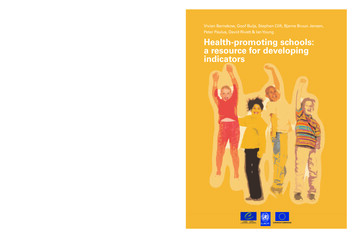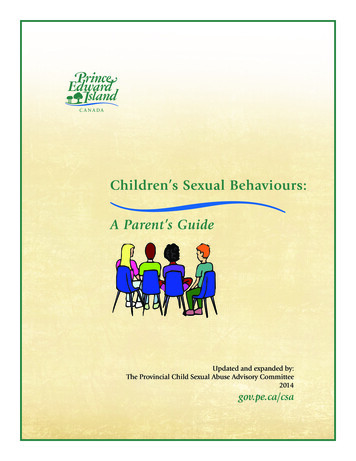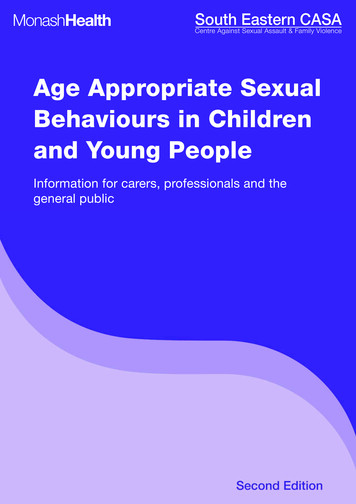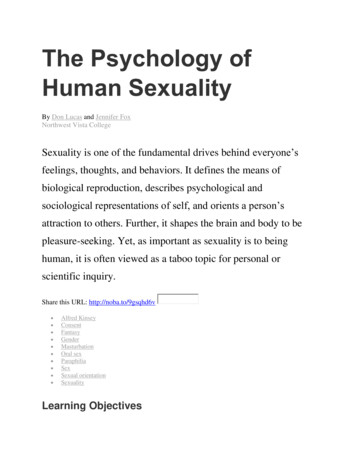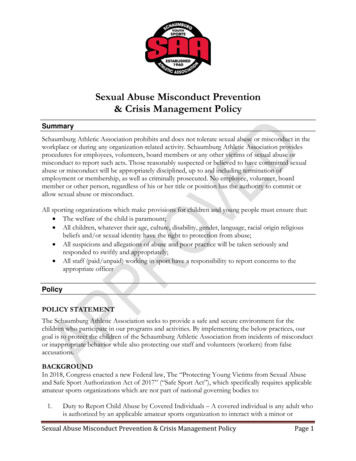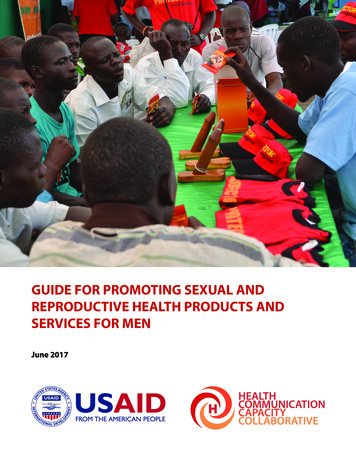
Transcription
GUIDE FOR PROMOTING SEXUAL ANDREPRODUCTIVE HEALTH PRODUCTS ANDSERVICES FOR MENJune 2017
This guide was made possible by the support of the American People through the United States Agency forInternational Development (USAID). The Health Communication Capacity Collaborative (HC3) is is supportedby USAID’s Office of Population and Reproductive Health, Bureau for Global Health, under CooperativeAgreement #AID-OAA-A-12-00058.Suggested Citation: Health Communication Capacity Collaborative (HC3). (2017). Guide for PromotingSexual and Reproductive Health Products and Services for Men. Baltimore, MD: Johns Hopkins Center forCommunication Programs (CCP).Contact:Health Communication Capacity CollaborativeJohns Hopkins Center for Communication Programs111 Market Place, Suite 310Baltimore, MD 21202 USATelephone: 1-410-659-6300Fax: 1-410-659-6266www.healthcommcapacity.orgCover Photo: The Uganda Health Marketing Group (UHMG), in partnership with the Strengthening TB and HIV/AIDS Response in eastern-central Uganda (STAR-EC), with funding from USAID, conduct a condom promotionfor the Protector brand at a rural fisher community. 2012 Kim Burns Case/JHUCCP, Courtesy of Photoshare. 2017, Johns Hopkins University. All rights reserved.iiGuide for Promoting SRH Products and Services for Men
ContentsACKNOWLEDGEMENTS ivACRONYMS vEXECUTIVE SUMMARY 1ABOUT THE GUIDE 2WHAT IS THE PURPOSE OF THIS GUIDE? 2WHO IS THIS GUIDE FOR? 2WHAT DOES THE GUIDE INCLUDE? 2HOW WAS THE GUIDE DEVELOPED? 3SECTION 1: OVERVIEW OF SRH PRODUCTS AND SERVICES FOR MEN 4WHAT IS SEXUAL AND REPRODUCTIVE HEALTH? 4SRH PRODUCTS AND SERVICES FOR MEN 4SECTION 2: INFLUENCING BEHAVIOR TO INCREASE THE UTILIZATION OF SRH PRODUCTS AND SERVICESBY MEN 9WHAT INFLUENCES BEHAVIOR? 9SOCIAL AND GENDER NORMS 11SBC ALONG THE SERVICE DELIVERY CONTINUUM 15BEFORE: DEMAND GENERATION AND PROMOTION OF SRH PRODUCTS AND SERVICES FOR MEN 16DURING: IMPROVING THE CLIENT EXPERIENCE WITH SRH PRODUCTS AND SERVICES 28AFTER: SUPPORTING BEHAVIOR MAINTENANCE 34SECTION 3: KEY CONSIDERATIONS FOR INCREASING MEN’S UTILIZATION OF SRH PRODUCTS ANDSERVICES 38DEVELOP AN SBC STRATEGY 38REACH THE RIGHT AUDIENCES 39USE GENDER TRANSFORMATIVE PROGRAMMING 47SELECT EFFECTIVE COMMUNICATION CHANNELS 50EXPLORE UNIQUE OPPORTUNITIES 56SECTION 4: RESOURCES AND TOOLS 64ENDNOTES 73IMAGES AND FIGURES 77Guide for Promoting SRH Products and Services for Meniii
ACKNOWLEDGEMENTSThe Health Communication Capacity Collaborative (HC3) – funded by the United States Agency forInternational Development (USAID) and based at the Johns Hopkins Center for Communication Programs(CCP) – would like to acknowledge Heather Chotvacs for authoring this guide with support from AllisonMobley and Arzum Ciloglu. HC3 thanks Anna Ellis and Kim Martin for their editing and layout support. HC3expresses its gratitude to FHI360/Evidence and Population Council for sharing literature reviews, whichhelped to inform the development of this guide. Finally, HC3 extends its gratitude to Hope Hempstone, RachelMarcus, Joan Kraft, Afeefa Abdur-Rahman, Angela Brasington and Andrea Ferrand at USAID/Washington fortheir invaluable guidance and support.ivGuide for Promoting SRH Products and Services for Men
VPMTCTPRO-PATERPSIRESPONDRMNCHRMNCH ASBCSDGSEEDAccess, Quality and Use in Reproductive Health ProjectAntiretroviral TherapyApplying Science to Strengthen and Improve Systems ProjectCommunity-based Family Planning ProgramsCommunity-based OrganizationsJohns Hopkins Center for Communication ProgramsCouples HIV Testing ServicesContraceptive Prevalence RateContinuous Quality ImprovementFamily PlanningFédération Internationale de Football AssociationGhana Vasectomy InitiativeHealth Communication Capacity CollaborativeHuman-Centered DesignHuman Immunodeficiency VirusHIV Testing and CounselingHIV Testing ServicesHuman PapillomavirusInformation Education CommunicationImplementation KitInterpersonal CommunicationInternational Planned Parenthood FederationInnovations in Family Planning Services Technical Assistance ProjectIntrauterine DeviceJohns Hopkins Health and Education South AfricaLow- and Middle-Income CountriesLearning Center InitiativeMale CircumcisionModern Contraceptive Prevalence RateMobile HealthMinistry of HealthMarie Stopes InternationalMen Who Have Sex with MenNational Basketball AssociationNon-Governmental OrganizationNo-Scalpel VasectomyProvider Behavior ChangeThe President’s Emergency Plan for AIDS ReliefPeople Living with HIVPrevention of Mother to Child TransmissionPromocão de Paternidade ResponsávelPopulation Services InternationalResponding to the Need for Family Planning through Expanded Contraceptive Choices andProgram Services ProjectReproductive, Maternal, Newborn and Child HealthReproductive, Maternal, Newborn and Child Health Adolescent HealthSocial and Behavior ChangeSustainable Development GoalSupply-Enabling Environment-DemandGuide for Promoting SRH Products and Services for Menv
iStrengthening Integrated Delivery of HIV/AIDS ServicesShort Message ServiceSexual and Reproductive HealthSexually Transmitted InfectionUrban Health InitiativeJoint United Nations Programme on HIV/AIDSUnited Nations Population FundUniversity Research Co, LLCUnited States Agency for International DevelopmentVoluntary Medical Male CircumcisionWomen’s International Network for Guatemalan SolutionsWorld Health OrganizationGuide for Promoting SRH Products and Services for Men
EXECUTIVE SUMMARYAchieving universal access to sexual and reproductive health (SRH) products and services is fundamentalto empowering women and men with the tools to live healthy lives and fulfill their reproductive intentions.As a key component of Sustainable Development Goal (SDG) 3 – to ensure healthy lives and promote wellbeing for all at all ages – universal access to SRH products and services plays an important role in preventingunplanned pregnancies, reducing maternal and newborn mortality and controlling and ending the HIVepidemic.Multiple global initiatives, including the SDGs and Family Planning 2020 (FP2020), focus on increasing accessto and utilization of SRH products and services; however, they largely focus on women and youth, oftenforgetting men have their own SRH needs and are important end-users of these products and services too. Asa result, men’s use of SRH products and services in low- and middle-income countries (LMIC) often lags behindwomen’s use.The Guide for Promoting Sexual and Reproductive Health Products and Services for Men focuses on meaningfullyengaging men and creating an enabling environment to increase men’s use of SRH products and services.Drawing on lessons learned from the promotion of male condoms, vasectomy, voluntary medical malecircumcision (VMMC), HIV testing services (HTS) and sexually transmitted infection (STI) testing and treatment,the guide provides guidance, resources and examples of approaches that have increased men’s use of SRHproducts and services in a variety of settings.In the guide, you will learn about programs that have successfully addressed harmful social and gender norms,which have traditionally excluded men from fully participating in their SRH care. You will also learn howprograms have addressed beliefs and misinformation, and built social support for men’s use of SRH productsand services using a variety of social and behavior change (SBC) approaches.The guide highlights key considerations for developing SBC strategies and activities for increasing men’s SRH,including: Developing an SBC strategy; Developing a deeper understanding of audiences; Segmenting audiences for better messaging; Tailoring messages to the life stages of men; Engaging women as partners and mothers; Promoting couples communication; Using gender transformative programming; Utilizing peer educators and mentors; Engaging community and religious leaders; Using technology: mobile health (mHealth), hotlines and social media; Providing high-quality comprehensive counseling; Branding SRH products and services for men; Using client testimonials and engage male champions; and Considering the timings and design of communication campaigns.By compiling lessons learned and key considerations for working with men, the Guide for Promoting Sexualand Reproductive Health Products and Services for Men is an essential resource for anyone working to achieveuniversal access to SRH products and services and improve health outcomes for men.Guide for Promoting SRH Products and Services for Men1
ABOUT THE GUIDEThe Guide for Promoting Sexual and Reproductive Health Products and Services for Men, referred to hereafter as“the Guide,” provides guidance and recommendations for developing strategic communication interventionsand activities to increase men’s demand for and utilization of sexual and reproductive health (SRH) productsand services.WHAT IS THE PURPOSE OF THIS GUIDE?The primary objective of the Guide is to support program managers and implementers in developingevidence-informed social and behavior change (SBC) interventions designed to increase men’s demand forand use of SRH products and services. The guidance and resources in this Guide will help program managersand implementers develop strong, tailored communication programs to better reach men with appropriatemessaging and calls to action, while successfully raising knowledge about SRH products and services,dispelling misinformation and transforming harmful social and gender norms, ultimately leading to betterhealth outcomes.WHO IS THIS GUIDE FOR?Program managers and communication professionals can use this Guide to reach men in low- and middleincome countries (LMIC) with SRH information, messages, products and services. Staff from ministries ofhealth (MOH), non-governmental organizations (NGOs) and community-based organizations (CBOs) will findrelevant resources, guidance and examples to support their work to reach and engage men as users of SRHproducts and services.While all levels of public health professionals can benefit from the Guide’s guidance, resources, tools andexamples, the Guide assumes users have a basic knowledge of SBC key concepts; however, the Guide includeslinks to key resources for those who need more information on basic SBC concepts.WHAT DOES THE GUIDE INCLUDE?The Guide highlights lessons learned, best practices and key insights from programmatic experiencein the promotion of male condoms, vasectomy, voluntary medical male circumcision (VMMC), humanimmunodeficiency virus (HIV) testing and treatment and sexually transmitted infection (STI) testing andtreatment services for men.This Guide focuses on highlighting what is unique about reaching and engaging men to increase theirutilization of SRH products and services and improve their health outcomes. The Guide does not includestep-by-step guidance on how to develop an SBC communication strategy, as the process for developing anSBC strategy is the same as for other audiences or health areas. References and links to other resources fordeveloping a strategy are included throughout the Guide and in the Resources and Tools section.The Guide is organized into four sections:Section 1: Overview of SRH Products and Services for Men: An examination of why the Guide focuses onengaging men as users of SRH products and services, and an overview of SRH products and services formen.Section 2: Influencing Behavior to Increase the Utilization of SRH Products and Services by Men: Anoverview of the multiple levels that influence men’s use of SRH products and services, and the role SBCplays across the SRH continuum of care – getting men to products and services, improving the clientexperience during service delivery and product purchase and supporting behavioral maintenance afterservice delivery or product purchase.2Guide for Promoting SRH Products and Services for Men
Section 3: Key Considerations for Increasing Utilization of SRH Products and Services by Men: Asummary of key considerations, lessons learned and emerging practices that should be considered whendesigning future SBC programs to increase men’s demand for and utilization of SRH products and services.Section 4: Resources and Tools: Links to resources, additional guidance and useful tools to assist in thedevelopment of strategic SBC promoting SRH products and services for men.HOW WAS THE GUIDE DEVELOPED?The Guide was developed by the Health Communication Capacity Collaborative (HC3) Project, led bythe Johns Hopkins Center for Communication Programs (CCP), in partnership with Population ServicesInternational (PSI), one of the core partners on the HC3 Project. The Guide draws on proven practices fromexisting programs and research on promoting male condoms, vasectomy, VMMC, HIV testing services (HTS)and STI testing and treatment services to men in LMIC.To inform the development of the Guide, HC3 reviewed literature reviews conducted by FHI360/Evidenceand Population Council on lessons learned in creating demand for and increasing use of vasectomy andSRH services for men respectively, and conducted a rapid review of peer-reviewed and grey literature on thepromotion of and demand generation for SRH products and services for men.Guide for Promoting SRH Products and Services for Men3
SECTION 1: OVERVIEW OF SRH PRODUCTS AND SERVICES FORMENOver the past three decades, SRH programs in LMICs have dramatically expanded access to and use of SRHproducts and services. These programs have traditionally focused on women of reproductive age, and ofteninclude male partners as influential decision makers; however, many programs have not focused directly onmen as end-users themselves.Globally, men’s use of SRH products and services is significantly less than women’s use. In 2013, the modernmethod contraceptive prevalence rate (mCPR) was 56 percent in LMICs, with male methods (such asmale condoms and vasectomy) accounting for only 8 percent of the mCPR (6.3 percent and 1.9 percent,respectively). In the least developed counties, male methods account for only 3 percent (male condoms 2.7percent and vasectomy 0.7 percent) of the mCPR of 30 percent.1 In a study of 29 countries in Africa, the mediannational uptake of HTS was 28.8 percent for women and 17.2 percent for men.2 Further, compared to women,men continue to access care at later stages of HIV infection. A global review based on 36 studies found thatbeing a heterosexual male was a consistent risk factor for presenting with low CD4 counts, resulting in worseoutcomes for men once enrolled in treatment. Additional evidence demonstrates that once men initiateantiretroviral therapy (ART), they often have lower retention and worse treatment adherence.3,4,5Multiple barriers prevent a man’s use of SRH products and services, including: a lack of awareness, knowledgeor access to products or services; negative beliefs and misinformation; and social and gender norms (includingnorms around men’s fertility and roles and responsibilities for reproduction and family planning). Gendernorms, for example, are important determinants of decisions to undergo HTS and subsequent progressionthrough the HIV care pathway.6 Men often avoid health facilities due to the belief that going to themdisplays weakness, embarrasses them and compromises their leadership position – all potentially degradinginternal perceptions of masculinity. Social norms regarding care-seeking and disclosure of HIV status presentsignificant barriers to access and adherence for men.7Strategic communication activities can address these issues by raising awareness of, increasing knowledgeabout and reducing normative barriers to men’s utilization of SRH products and services.The Guide focuses on men as a general population, providing guidance and relevant program examplesthat are generalizable and can be applied to diverse segments of men across different regions and countries.Where appropriate, links to resources for reaching specific populations have been included, such as resourcesfor reaching youth.WHAT IS SEXUAL AND REPRODUCTIVE HEALTH?According to the United Nations Population Fund (UNFPA), “good SRH is a state of complete physical, mentaland social well-being in all matters relating to the reproductive system. It implies that people are able tohave a satisfying and safe sex life, the capability to reproduce and the freedom to decide if, when and howoften to do so.”8 Good SRH depends on equal access to accurate SRH information and high-quality, affordableSRH products and services for men, women and other gendered groups (i.e., individuals who identify astransgender, intersex, third gender, etc.), as well as autonomy in sexual and reproductive decision-making.SRH PRODUCTS AND SERVICES FOR MENWhile most SRH products and services focus on women as the end-users, a growing number of SRH productsand services are available to provide men with the ability to space or limit pregnancies, prevent and treat STIs,prevent and treat HIV and improve their SRH. This Guide focuses on five of these products and services: malecondoms, vasectomy, VMMC, HTS and STI testing and treatment.4Guide for Promoting SRH Products and Services for Men
Some additional SRH products and services for men are not included in the Guide due to their limitedavailability in LMIC and/or limited research on their use in these settings. These include products and servicesfor infertility, impotence, male reproductive system cancers and psychosocial sexual health. However,as mentioned above, the Guide is generalizable and may be applied to the development of strategiccommunication interventions and activities for these other products and services.Male CondomsA male condom is a thin latex or polyurethane sheath that is placed over the entire shaft of the penis toprevent pregnancy and reduce the risk of transmitting and acquiring STIs, including HIV.Male condoms, when used correctly and consistently, are effective at preventing pregnancy by preventingsemen from entering a woman’s vagina during sexual intercourse; thereby preventing sperm from fertilizingan egg. Similarly, male condoms prevent the transmission of STIs during oral, vaginal and anal sex bypreventing the exchange of semen and vaginal fluids and reducing skin-to-skin contact with mucosal surfaces,all known pathways for the transmission of various STIs.Under typical use (i.e., using a condom during most, but not every, sexact), male condoms have a pregnancy failure rate of 18 percent. Thismeans that 18 of every 100 men who use only male condoms duringsexual intercourse will have a female partner who experiences anunplanned pregnancy in a year. This percentage can be reduced to twopercent, if male condoms are used correctly and consistently with everysex act.9Male condoms, when used correctly and consistently, are 90 to 95 percenteffective at preventing HIV transmission between HIV discordant couples(couples in which one person is infected with HIV and the other is not).Under typical use, the effectiveness of male condoms at preventing HIVtransmission is reduced to 79 percent.10With regards to other STIs, male condoms are most effective at preventingSTIs that are transmitted via semen and vaginal fluids, includinggonorrhea, chlamydia and trichomoniasis. Male condoms are lesseffective at preventing STIs that are primarily transmitted through skinto-skin contact, such as genital herpes, syphilis, chancroid and humanpapillomavirus (HPV).11 This is due to the fact that male condoms donot prevent all skin-to-skin contact; however, male condoms are stillhighly recommended for STI prevention as they do reduce the risks oftransmission and acquisition.Image 1: Illustration of male condomVasectomyVasectomy is a permanent, surgical form of male sterilization. Duringvasectomy, the vas deferens – the tubes that carry sperm from thetesticles to the penis – are tied, severed or otherwise sealed to preventsperm from mixing with seminal fluid. Instead, the sperm are absorbed bythe body and are not released during ejaculation. As a result, the seminalfluid of a man who has undergone a vasectomy does not contain spermand therefore is unable to fertilize an egg.Vasectomy is one of the most effective modern methods of contraception,with a pregnancy failure rate of approximately 0.15 percent. This meansGuide for Promoting SRH Products and Services for MenImage 2: Illustration of vasectomy5
that in the first year after vasectomy, less than one of every 100 men who have undergone vasectomy willhave a female partner who experiences an unplanned pregnancy.12Vasectomy is safer and more cost effective than surgical female sterilization with tubal ligation because it isgenerally a much shorter procedure, does not normally require an incision and requires less recovery timethan tubal ligation.13While a highly effective form of contraception, vasectomy does not prevent STIs, including HIV.Voluntary Medical Male CircumcisionVMMC refers to the complete removal of the penile foreskin. It is the only permanent, surgical interventionused for HIV prevention and is highly effective at preventing new HIV infections in males. Three randomizedcontrolled trials have shown VMMC reduces men’s risk of HIV infection from vaginal intercourse by atleast 60 percent.14,15,16 VMMC has been proven to reduce HIV transmission to males exposed to the virusthrough vaginal intercourse with HIV-infected females. Although VMMC has not been proven to reduce HIVtransmission from HIV-infected males to their female sexual partners, as more males get circumcised in thecommunity, the likelihood of them being HIV infected is reduced, therefore reducing the HIV infection risk towomen.In addition to effectively reducing the risk of heterosexual transmission of HIV from females to males duringvaginal intercourse, VMMC provides other health benefits to men and women, including reducing HPV, genitalulcer disease, bacterial vaginosis and trichomoniasis among female partners while also reducing the risk ofpenile cancer in men.17In recognition of the potential of VMMC to reducenew HIV infections, the Joint United NationsProgramme on HIV/AIDS (UNAIDS) and the WorldHealth Organization (WHO) promote VMMC for HIVprevention in countries with high HIV prevalenceand low male circumcision coverage. Since 2007,the scale up of VMMC for HIV prevention has beenprioritized in 14 countries in Southern and EasternAfrica, including Botswana, Ethiopia, Kenya, Lesotho,Malawi, Mozambique, Namibia, Rwanda, SouthAfrica, Swaziland, Uganda, Tanzania, Zambia andZimbabwe.18Image 3: Illustration of VMMC using Dorsal Split methodHIV Testing ServicesIn 2015, men accounted for approximately 49percent of all adults (age 15 and above) living withHIV worldwide. Of the estimated 1.9 million newHIV infections reported in 2015, 53 percent of theinfections were among men.19 HTS is an importantcomponent of the continuum of HIV prevention, careand treatment services. HTS is the entry point forindividuals to know their HIV status while becomingeducated about HIV and their own risk behaviors,and to be linked to care and treatment, if HIVpositive.HTS includes pre-test information, quality HIV testing(using either a rapid or laboratory test), post-test6Image 4: Man receiving HTS during an outreach eventGuide for Promoting SRH Products and Services for Men
counseling and linkages to appropriate HIV prevention, care and treatment services and other clinical andsupport services, as needed.HTS should follow the WHO’s five essential standards20:1. Consent: Men receiving HTS must give informed consent to be tested and counseled. They should beinformed of the process and of their right to decline testing.2. Confidentiality: HTS is provided in a confidential manner, meaning that what the provider and a mandiscuss will not be shared with anyone else without the expressed consent of the man being tested.Although confidentiality should be respected, it should not reinforce secrecy, stigma or shame. Providersshould discuss with whom a man may want to inform of his results (i.e., his wife, girlfriend, sexualpartners, family members and friends), how they would like this to be done, etc.3. Counseling: HTS must be accompanied by appropriate, high-quality pre-test and post-test counseling.Quality assurance mechanisms and supportive supervision and mentoring systems should be utilized toensure high-quality counseling.4. Correct test results: Providers should provide high-quality testing services, and quality assurancemechanisms should be in place to ensure the correct test results are given to men being tested.5. Care and treatment services: HTS should provide linkages to prevention, care and treatment services.This includes the provision of effective referrals to follow-up services as indicated, including long-termprevention and ART support.STI Testing and TreatmentSTIs include more than 30 bacterial, viral and parasitic infectionsthat are predominantly transmitted from person-to-personduring oral, vaginal or anal sex. Some STIs can also be spreadvia blood and from mother-to-child during pregnancy andchildbirth.Globally, more than one million men and women acquirea STI each day.21 The eight most common STIs globally arechlamydia, gonorrhea, syphilis, trichomoniasis, hepatitis B,human papillomavirus, herpes simplex virus and HIV. Of theseeight STIs, four are curable (chlamydia, gonorrhea, syphilis andtrichomoniasis) and four are treatable, but no cure currentlyexists (herpes simplex virus, HIV, hepatitis B and HPV). Effectivevaccines exist to prevent hepatitis B and some strains of HPV.22STI testing and treatment services are an important healthservice for ensuring the SRH of men. Untreated STIs in mencan lead to serious long-term health consequences, includinginfertility, increased risk of HIV acquisition, penile cancer,prostatitis, epididymitis and reactive arthritis.23Image 5: Man receives STI counselingSince many STIs are asymptomatic in men, STI testing andtreatment services for men also have important health implications for women. Routine untreated STIs inmen place their female sexual partners at greater risk of acquiring a STI. In women, untreated STIs can leadto serious long-term health consequences, including infertility, increased risk of HIV acquisition, femalereproductive system cancers (cervical, vagina a
a result, men’s use of SRH products and services in low- and middle-income countries (LMIC) often lags behind women’s use. The Guide for Promoting Sexual and Reproductive Health Products and Services for Men focuses on meaningfully engaging men and creating an enabling environment to increase




